

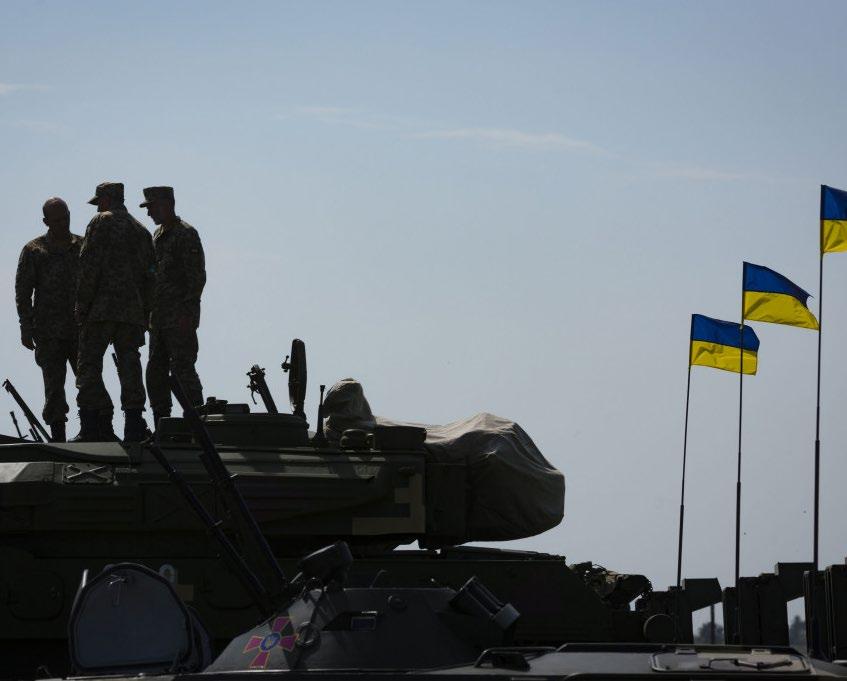
MONTHLY September 2022
SOURCE: WIKIPEDIA
PUTIN, XI MEETS IN SAMARKAND: CHINA IS RUSSIA’S SENIOR PARTNER
RUSSIA INCREASES LNG OUTPUT
PUTIN TO FORMALLY ANNEX UKRAINIAN REGIONS
UKRAINE’S ATTACK NEAR KHARKIV POSES A THREAT TO RUSSIA’S GOALS IN THE DONBAS
WHY UKRAINE WAR MATTERS FOR CHECHNYA’S KADYROV
UKRAINE TAKES STRATEGIC INITIATIVE ON TWO FRONTS
WHAT PUTIN’S PARTIAL MOBILIZATION IN RUSSIA MEANS FOR UKRAINE
TENSIONS RUN HIGH BETWEEN ARMENIA, AZERBAIJAN, TESTING RUSSIAN REGIONAL AMBITIONS
STICK OR CARROT: RUSSIA APPROVES STRICTER WARTIME PUNISHMENTS
SHAM REFERENDA IN RUSSIANCONTROLLED UKRAINIAN REGIONS
RUSSIA’S “PARTIAL” MOBILIZATION: PUTIN DECEIVED FELLOW CITIZENS
RUSSIA THREATENS NUCLEAR WEAPONS USE
GAZPROM’S DIVIDENDS: LESS GAS, MORE MONEY

RUSSIA ANNOUNCED RESULTS OF SHAM VOTE IN RUSSIAN -OCCUPIED LANDS
PUTIN, XI MEETS IN SAMARKAND: CHINA IS RUSSIA’S SENIOR PARTNER
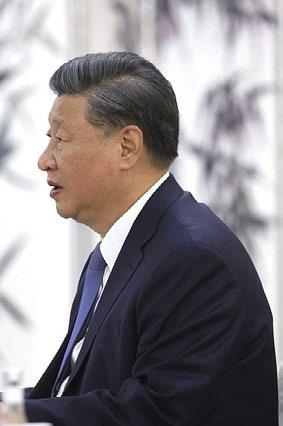
MONTENEGRO DETAINS RUSSIANS ON SUSPICION OF SPYING
RUSSIAN OIL AND GAS RESOURCES: HOW MUCH AND FOR HOW LONG?
TALIBAN-RULED AFGHANISTAN IS NEW MARKET FOR RUSSIAN FUEL
RUSSIA INCREASES LNG OUTPUT

RUSSIA REAFFIRMS ITS COMMITMENT TO DEVELOP PAKISTAN’S GAS SECTOR
UKRAINE CLAIMS CONTROL OF LYMAN, ENCIRCLING RUSSIAN TROOPS
UKRAINE APPLIES FOR FAST -TRACK NATO ADMISSION
PUTIN TO FORMALLY ANNEX UKRAINIAN REGIONS
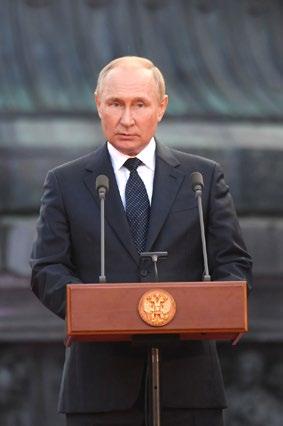
www.warsawinstitute.org2
CONTENTS 21 27 33 18 33 16 31 15 30 13 28 11 27 10 26 8 24 7 23 5 21 3 20
September 2022
UKRAINE’S ATTACK NEAR KHARKIV POSES A THREAT TO RUSSIA’S GOALS IN THE DONBAS
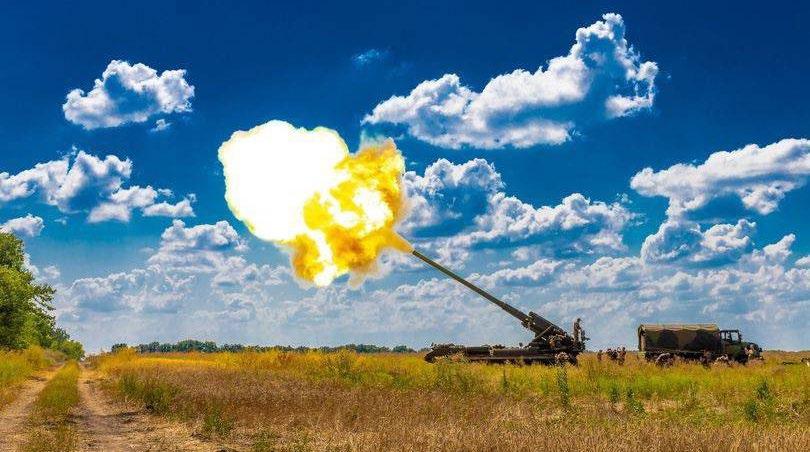
As of now, three theaters of land warfare can be distinguished in Russia’s war with Ukraine. One is the southern front, mainly the Kherson region, or more precisely its part on the western side of the Dnieper River. To the east, there are two major fronts. Until recently, the key one had been the Donbas, but the last days on the Kharkiv front turned out to be of great importance for the power balance along the border of the Luhansk and Donetsk regions.
Last week’s Ukrainian offensive on the right bank of the Dnieper, between Nikopol and Kherson, made the Russian command concentrate its attention on the southern front, where, in previous weeks, it had already
redeployed a significant part of its forces. Since the constant goal of the Russian commanders (which Putin demands to be achieved) is the seizure of the entire Donbas, the concentration of their troops in the Kharkiv region has
www.warsawinstitute.org 3
8
SOURCE: TWITTER
necessarily weakened. However, for a long time, Russia’s goal has been to destroy Kharkiv with shelling and to secure the key supply line that runs north to south from the Russian town of Valuyki, through the Ukrainian town of Kupiansk, all the way to Izium. This line mainly comprises the P-79 road and the railroad. Recent developments in the south resulted in the Russians probably even halving the size of their troops in the Izium direction and getting rid of its better half. Almost all of the line units returned to the southern banks of the Dnieper River.
Some 10,000–15,000 troops remained at Izium, among whom many were not well-qualified: reserves, National Guard of Russia troops, and “militias” from the so-called people’s republics in the Donbas, largely composed of forcibly conscripted residents of the region. All this was an open invitation to the enemy. On Tuesday, September 6, many alarming posts appeared on Russian social media profiles monitoring the war situation regarding the major progress of Ukrainian forces advancing near Balakliia (which the Russians seized in March).
According to available data, in the first hours, the Ukrainians had already made a breakthrough at least 15 kilometers deep in the northwest of Balakliia, laid fire on access roads, and then seized the city. It is an important transportation hub northwest of Izium, with the T2110 road running from north to south and the P78 road stretching from east to west intersecting here. The Ukrainians then moved toward Volokhov Yar and Shevchenkove –heading north of the T2110 road. Both places were seized within the next 24 hours.
The main axis of the Ukrainian military offensive runs from the southwestern part, from above the Seversky Donets, to the northeastern one, toward Kupiansk on the Oskil River. If it succeeds, it will mean destroying not only Russia’s main supply route for the Izium outpost but also cutting off the Russians on the west side of the Oskil River – which, in the
stretch between Izium and Kupiansk, is broad and has no passages to the other side. The auxiliary axis of the attack is the southeastern direction to Izium, along the P78 road.
As was the case a week ago in Kherson, it would be premature to judge actual Ukrainian successes based on the first two days of the offensive. Undoubtedly, however, the first conclusions can already be drawn. The Ukrainian army has demonstrated its ability to assemble groups reinforced with reserves for simultaneous offensives in two very distant directions – the Kherson region and the Kharkiv region. This could make the Russian commanders even more nervous and even provoke ill-advised decisions, for instance, in the Donbas.
An offensive on Kupiansk could trap the Russians in the Izium region or force them to retreat from that direction. This, in turn, would worsen Moscow’s strategic position on the Donbas front. So far, the presence of the enemy in Izium has been a serious problem for Ukrainian defenses in Sloviansk and Kramatorsk. A strike from the left flank was still a threat (although Russian offensives in this area ceased as recently as early summer, following several weeks of attempts to break Ukrainian defenses). What is more, Ukrainian troops attacking from the west, if they were able to cross the Oskil River in Kupiansk, would emerge at the very back of Russian forces attacking from the Luhansk region to the south. The enemy’s successes north of Izium are already affecting the attitude of the Russians in the Donbas, where they have been slowly occupying land for weeks, mainly in the Bakhmut direction. In the Donetsk region, Ukrainian forces have moved several kilometers each and the village of Ozerne, located between Sloviansk and Siversk, has been liberated.
It must be pointed out that the offensive launched a week earlier in the Kherson region was not, as some claim, just a classic “fog of war”, a false move to draw the enemy’s attention
www.warsawinstitute.org4
away from the Kharkiv Oblast. Ukrainians are using artillery, aviation, and combat drones up to 50–70 km into the front line. The goal is not to make rapid progress on land, but to exhaust the enemy and cut it off from their support base on the east bank of the Dnieper. This will either force the Russians to retreat or become so weakened that the Ukrainian groups will be able to launch further land-based armored attacks. As the deputy head of the main operational board of the General Staff of the Armed Forces of Ukraine, General Oleksiy Hromov, reported following two days of the offensive in the Kharkiv region and more than
a week of the offensive in the Kherson region, Ukrainians have recaptured more than 700 square kilometers of its territory in the Kharkiv region and southern Ukraine. In the Kharkiv direction, they moved up to 50 km deep into the enemy’s lines of defense. More than 20 towns or villages were liberated. Finally, an interesting fact is that on the eve of the strike near Kharkiv, President Volodymyr Zelenskyy suggested in an interview with the American ABC TV channel that Ukrainian attacks in the Kherson direction are not the only axis of the offensive led by Kyiv. And that the Ukrainians wish to surprise their enemy. ■
September 2022
WHY UKRAINE WAR MATTERS FOR CHECHNYA’S KADYROV
Sharp, or even hysterical, criticism of the Russian military shows how important the fate of the war in Ukraine is for Ramzan Kadyrov. The leader of Chechnya has strong ties to Vladimir Putin––but not Russia. If Putin’s regime fell, Kadyrov would have trouble retaining power in the region. Thus the Kremlin-installed leader is anxious to see Russia winning the war it had started in Ukraine.
On September 12, Kadyrov said he would be sending what he referred to as “elite troops” to Ukraine, led by Adam Delimkhanov. According to footage published by Delimkhanov––Kadyrov’s close associate––some 10,000 Chechen have been deployed to Ukraine’s regions of Donetsk, Zaporizhia, and Kherson. They are not in Kharkiv where the Ukrainian army won a clash with the Russians––they are along the southern front shooting their comrades seeking to leave without permission. Seemingly, the Chechen strongman has put all his eggs in one basket. He is Russia’s only
regional leader to have deployed most people to war-torn Ukraine while calling for radical efforts and criticizing failures like that in the Kharkiv region. Chechnya’s notorious leader also took to Telegram to voice his outrage and in a video message blamed Russia’s Defense Ministry, for the “loss of the Kharkiv region.” He added: “They have made mistakes and I think they will draw the necessary conclusions.” Kadyrov’s anxiety is growing, which is not surprising at all. A lost war will topple Vladimir Putin’s regime, thus prompting a clash between Kadyrov and Moscow elites seeking to take
www.warsawinstitute.org 5
20
revenge on the Chechen warlord. Putin and Kadyrov have a special deal that makes the latter untouchable for FSB and SVR chiefs, Medvedev, or Shoigu. And yet Kadyrov has a bunch of enemies elsewhere who are seeking to seize an opportunity in defeating Russia militarily. There are now four battalions comprising the Chechen nationals fighting alongside the Ukrainians. Kadyrov routinely brands them as “cowards,” “alcoholics” or “rats.” But those people could one day pose a threat to the Chechen strongman. In July, the Ukrainian parliament submitted a draft bill calling for the recognition of the Chechen Republic of Ichkeria, which was de facto independent in the
1990s following the First Chechen War and the Khasavyurt Accord of 1996. Chechen fighters siding with the Ukrainian army say their next goal will be to liberate their homeland. Kadyrov knows he must nip these efforts in the bud. About 1,500 Kadyrov troops were sent into Ukraine, mostly to reinforce the Russians in the Kherson region. Formally, they are part of Rosgvardia––a militarized force separate from the army in 2016, commanded by Gen. Viktor Zolotov, a close Putin confidante and his former top bodyguard. Kadyrov said he would be sending more troops to aid the Russians in their fight against Ukraine. ■

www.warsawinstitute.org6
SOURCE: KREMLIN.RU
September 2022
UKRAINE TAKES STRATEGIC INITIATIVE ON TWO FRONTS
Ukraine’s military says it has broken through Russia’s first line of defense in the Kharkiv region while advancing towards the Kherson region. Russia has no trained reserve personnel. Moscow has no longer an advantage on land, with its only assets remaining as missile attacks throughout Ukraine and a navy blockade.
Ukraine has scaled down its offensive in the country’s east. The state’s military command refused a further march putting at risk Ukrainian personnel. A strong Russian “Centre” group has continued its slow advance towards Bakhmut and Sloviansk. They were supplemented with the “West” group of troops that had withdrawn from Izium. It is now a
top priority for Kyiv to strengthen its hold on recently recaptured territories west of the Oskil River. Ukrainian President Volodymyr Zelensky visited the recently retaken city of Izium, marking a successful operation to oust the Russians from the Kharkiv region. The crushing Ukrainian victory in the Kharkiv region should not overshadow the successes around Kherson
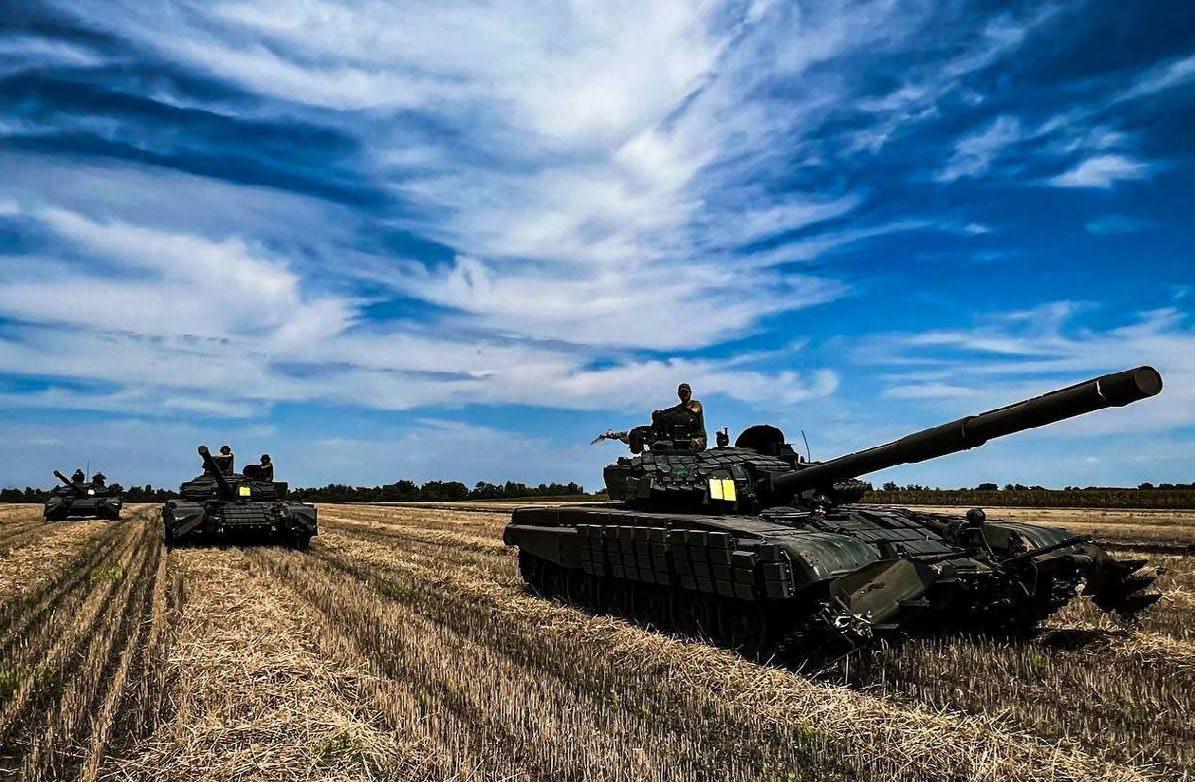
www.warsawinstitute.org 7
20
SOURCE: TWITTER
despite small territorial gains. The offensive in the south did not go as smoothly as in the Kharkiv region due to terrain constraints. In the east, Ukrainian forces were sheltered by a dense stand of pine forests, able to deploy armored forces unnoticed. Ukraine’s south is predominantly an agricultural area––with few forests and numerous steppes shattered with irrigation channels. It is in the south that Russia has deployed its best personnel and Chechen battalions, or barrier troops, with orders to shoot if front-line troops either deserted or retreated without permission. But the Russian command made a mistake when directing most reinforcements to the right bank of the Dnieper River from the east. Left at that side of the river, the Russian grouping is now in a tough position. About 20,000 Russian soldiers are now stranded in Kherson. Ukrainian officials have said their deployment has been critical in the fight to
repel Russian troops and to strike their supply lines on the Dnieper. In consequence, Russian troops retreat south towards Kherson along the river. What is now key in morale after the Ukrainian “Blitzkrieg” by Kherson. The Russian forces have poor morale–– not incidentally, Russian troops on the right bank of the Dnipro have started negotiating their surrender with Ukrainian forces. Tensions run high between the Kremlin and top Russian generals. Whether the army is loyal to Russian state officials is yet another thorny issue. The military command of the Russian Federation has suspended the sending of new, already formed units into the territory of Ukraine. Kremlin-loyal Russian propaganda outlets seek to blame the army for failures––and not Putin. What the army will do next is unknown. The attitude of Defense Minister Sergei Shoigu could be crucial here. ■
2022
WHAT PUTIN’S PARTIAL MOBILIZATION IN RUSSIA MEANS FOR UKRAINE
Russian President Vladimir Putin on Wednesday announced a partial military mobilization in Russia. He also expressed support for staged referendums that would allow the annexation of occupied Ukrainian territory. The Russian leader has thus admitted defeat in Ukraine. What he labeled as a “special military operation” has turned into an all-out war while Russian efforts to claim four regions that Moscow has not captured fully are nothing but a frantic attempt to restore control.
One more thing was evident in Putin’s televised speech, broadcast this Wednesday. The Russian leader said the main goal of the campaign remained “the liberation” of the entire territory of Donetsk and Luhansk
regions. Russia was no longer requesting Ukraine be “denazified” or “demilitarized,” with a Kremlin-controlled government to be installed in Kyiv. Moscow seems to have comprehended it could seize just some swathes
www.warsawinstitute.org8
21 September
of Ukrainian territory as back in 2014. This might not be easy, which is why Putin declared a partial mobilisation. Interestingly, the Russian leader spoke of “partial” mobilization. The Kremlin indeed misjudged its forces and those of Ukraine, believing volunteers and mercenaries would be enough to tip the scale. Not only was Russia doomed to failure in the whole war, but it was unable to seize the whole Donbas while there was a threat of being defeated. Russian top military brass must have comprehended it earlier, but it was only after a failed operation in Kharkiv that Vladimir Putin became bitterly aware of that. Some 300,000 reservists are to be called up for partial mobilization, according to Defense Minister Sergei Shoigu. But will this be enough?
First, mobilizing even half of this number would be considered a success. Secondly, these troops will not be sent to the front until autumn or winter. Putin’s mobilisation plans thwart Ukraine’s war strategies on the front. A real game-changer would be to formally annex swathes of occupied territories. The Kremlin could then say fighting takes place in Russia while military personnel is regular conscripts.
Furthermore, Moscow could dispatch more conscripts to the front as it is now prohibited to send such troops abroad. Politically, “sham referendums” could matter most to the authorities in Kyiv. Russian-backed separatists will hold referendums on joining Russia between September 23-27. Neither Western nations nor Ukraine will recognize them. The U.S. and the EU have announced new sanctions on Russia. Kyiv made it clear: any efforts like that would ditch any peace talks in the future. When deciding to annex swathes of Ukrainian territory, Putin has opted for a long-lasting allout war that requires more personnel, partially mobilized for now. The Kremlin assumes that this will be enough, because the energy crisis in Europe caused by Russia’s policies plus even stronger, after the annexation of part of Ukraine, threats to use nuclear weapons will eventually force the West to soften its policy toward Moscow and seek other solutions, including through pressure on Ukraine. Putin’s televised speech has so far backfired, though. The Western response has been uniform and firm––perhaps Kyiv will receive more weapons amid escalating threats from Russia. ■

www.warsawinstitute.org 9 SOURCE: МУЛЬТИМЕДИА.МИНОБОРОНЫ.РФ/
SOURCE:MOD.GOV.AZ
September 2022
TENSIONS RUN HIGH BETWEEN ARMENIA, AZERBAIJAN, TESTING RUSSIAN REGIONAL AMBITIONS
Deadly clashes that erupted along the border between Azerbaijan and Armenia near the disputed territory of Nagorno-Karabakh challenge the militarily weak Armenia and Russia’s allied commitments. A successful Azerbaijani offensive in Armenia would mark Russia’s weakness and its being inept to deliver allied commitments in the post-Soviet zone.

www.warsawinstitute.org10
21
On September 13, Armenia began to be bombarded by artillery fire from neighboring Azerbaijan. Armenia’s leader urged Russia to consider providing security assistance. Russia said on September 13 that it had mediated a ceasefire. But the next day, fighting resumed between the two conflicting countries. Fighting on the border between Armenia and Azerbaijan killed 99 troops in their worst fighting since the 2020 war over the disputed Nagorno-Karabakh region. Armenia has accused Azerbaijan of shelling its territory while the authorities in Baku claim Armenian troops mined roads and thus hindered efforts to reconstruct territories reclaimed back in 2020. Perhaps it was indeed an Armenian provocation as the self-proclaimed republic in Nagorno-Karabakh feels disappointed with the policy of Nikol Pashinyan seeking to put an end to the long-lasting feud. But the offensive side is Azerbaijan and it wants to take advantage of the weakness of Armenia and Russia, the latter involved in the war in Ukraine. The current hostilities in the South Caucasus are testing the Russian status quo in the region. Following the Russian invasion of
September 2022
Ukraine, Azerbaijan has made three attempts to pressure Armenia for concessions via force. No response from Moscow was noted, though. Russian “peacekeepers” in Nagorno-Karabakh and troops in the Gyumri military facility did not respond to Azerbaijan’s efforts to capture new swathes of land. But indeed, Azerbaijan was allowed to claim these territories under the 2020 deal, but Armenia hindered this operation. Unlike in previous clashes, Azerbaijan carried out a wide-scale attack against targets in mainland Armenia. The immediate reaction of Armenia was to ask the help of Russia, with which it is linked by a Collective Security Defense that should have activated military assistance from the Russian side. But there is no military assistance from Russia. Moscow and the Collective Security Treaty Organization (CSTO) have reacted more actively yet only politically. Trapped in its flawed military invasion of Ukraine, Moscow could not assist Armenia and thus will want to get concessions from Armenia. But fighting has revealed how weak Moscow is while other former Soviet republics should not seek an ally in Moscow. ■
STICK OR CARROT: RUSSIA APPROVES STRICTER WARTIME
PUNISHMENTS
Russia has for months struggled with military personnel deficits. When Moscow ran out of its regular personnel, it had to resort to volunteers and mercenaries. This was too little so Vladimir Putin announced an immediate partial mobilization of its reservists. They are enticed with decent salaries but they face toughened punishments for desertion or insubordination.
www.warsawinstitute.org 11
22
Russian President Vladimir Putin on September 21 signed a decree on partially mobilizing Russia’s reserves. Under the document, “citizens of the Russian Federation called up for military service by mobilization have the status of military personnel serving in the Armed Forces of the Russian Federation under a contract” (Point 2). In addition, “the level of remuneration for citizens of the Russian Federation called up for military service by mobilization corresponds with the level of pay for military personnel” (Point 3). New reservists mobilized from September 21 on will enjoy a far better status that regular conscripts, a move not to discourage men sent to the front line upon short military training. If the salary was decent enough, there would already be many enough people to serve in the army. But the Kremlin believes these incentives could not be enough. This is why Russian lawmakers approved a bill that toughens punishments for
crimes if they are committed during military mobilization or combat situations. A day before Putin announced a partial mobilization, the State Duma, the lower house of the Russian parliament, approved a bill toughening punishments for desertion or failure to show up. According to the bill, mobilization, martial law, wartime, and armed conflict will be considered as aggravating circumstances, and entail more severe punishments. According to new Article 352 of the Criminal Code, those who surrender can now face between three and ten years in prison provided that there is no sign of treason. Any person committing this crime for the first time “may be exempted from criminal liability if he has taken steps to free himself, has returned to his unit or duty station, and has not committed other crimes during his captivity.” Under the amendments endorsed by the State Duma, the lower house of Russia’s parliament, there will be a 10-year

www.warsawinstitute.org12
SOURCE: KREMLIN.RU
prison sentence for desertion, failure to report for military service, and surrender. Reservists or contract soldiers who fail to show up can face up to 10 years in prison. Under Article 338 of the Russian Criminal Code, desertion is punishable by up to 15 years in prison. Nonexecution of the state defense order “if issued during mobilization, during wartime, or under martial law and refusal to participate in military or combat operations” is punishable between two and three years in prison (Section 2.1 of Article 332 of the Criminal Code). Russian
reservists called up for military training will be criminally liable on an equal basis with contract soldiers and conscripts for failure to appear. So far, contract soldiers have served under a sixmonth contract; they could until now refuse to take part in a military operation before returning to their home base and handing in their resignation. They indeed were exposed to pressure while many resignations were turned down yet no one faced criminal punishments. The decree has changed this. ■
2022
SHAM REFERENDA IN RUSSIAN -CONTROLLED UKRAINIAN REGIONS
The results of these “referenda” are known well in advance. Russian President Vladimir Putin likely intends to annex occupied southern and eastern Ukraine directly into the Russian Federation in a few days. This operation is aimed at mobilizing Putin’s supporters in Russia and stoking fears of nuclear attacks if Ukrainian forces liberate the whole regions of Kherson, Zaporizhzhia, Donetsk, and Luhansk.
Voting there is due to run from September 23 to 27. In Donetsk and Luhansk — which Putin already recognized as independent before invading Ukraine in February — residents are answering if they support their “republic’s entry into Russia.” Ballots in Kherson and Zaporizhzhia ask the question: “Are you in favor of secession from Ukraine, formation of an independent state by the region and its joining the Russian Federation as a subject of the Russian Federation?” Representatives of the Moscow-installed military administration in the occupied parts of Ukraine’s Kherson
region visit homes, forcing people to attend Russian-staged referenda. People in the regions Russia has seized this year are also coerced into casting a ballot. If any person refuses to vote or casts a “no” ballot, men could be called up to the Russian army while women––asked to leave their houses. No international journalists or observers are present for the sham proceedings. Ukraine and its Western allies have said that they will not recognize the Russian annexation of Ukrainian territories. Russia is already claiming a turnout of 45 percent on the pseudo-referendum show to annex the
www.warsawinstitute.org 13
26 September
territories it claimed back in June and July. No census is available while cities like Lysychansk or Severodonetsk were literally razed to the ground. While these votes are sham and their results rigged, the Kremlin is seeking to make them look “democratic.” The Ministry for Reintegration of the Temporary Occupied Territories of Ukraine listed eight countries that had provided their observers for sham referenda. Those are representatives of Belarus, Syria, Egypt, Brasil, Venezuela, Uruguay, Togo, and South Africa. Ukraine demanded an urgent meeting of the UN Security Council over the holding of pseudo-referenda in the Russianoccupied territories of Donbas. The meeting is scheduled for September 28, which is when the sham referenda will end. The State Duma, Russia’s lower house of parliament, may be
submitted bills incorporating Russian-occupied parts of Ukraine into Russia on September 28 before debating them the next day. Proceedings will wrap up on September 30, with Putin’s address to both houses of the Russian parliament to announce the incorporation of Ukraine’s regions of Donetsk, Luhansk, Kherson, and Zaporizhzhia into Russia. Earlier that day, agreements will be signed to include four regions in the Russian Federation. Putin is likely to use the referenda to stoke fears that Russia could deploy nuclear weapons to scare off a Ukrainian offensive. The Russian military doctrine says Russia “reserves the right” to use nuclear weapons to respond to all “weapons of mass destruction” attacks if the country is at any risk. ■
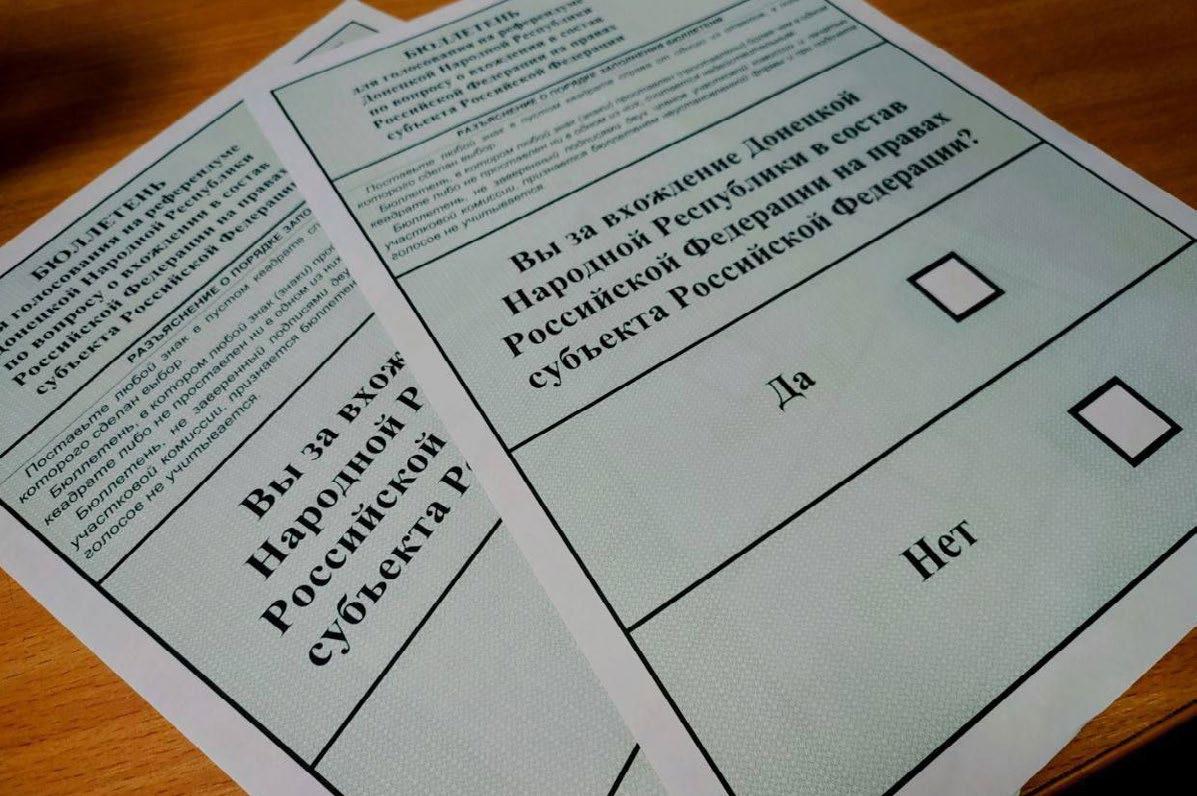
www.warsawinstitute.org14
SOURCE: TWITTER
RUSSIA’S “PARTIAL” MOBILIZATION: PUTIN DECEIVED FELLOW CITIZENS
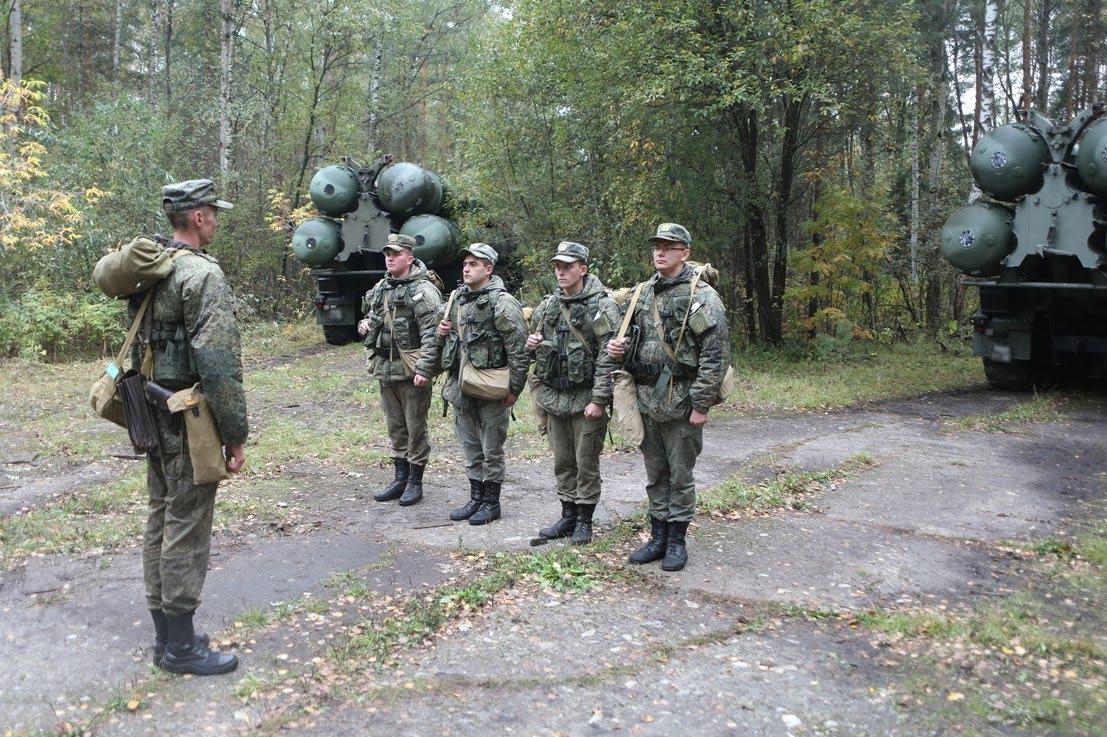
The classified seventh paragraph of the decree of Vladimir Putin contains information on the mobilization volume, which now remains unknown. Russian Defense Minister Sergei Shoigu made reference to up to 300,000 people being mobilized in phases but some news outlets reported that the real target is four times as many. Contrary to what Putin said, the military call-up is not partial, but widespread, while it is state authorities that decide who is summoned.
Russian authorities on September 24 detained more than 700 people at protests against the partial mobilization ordered by
President Vladimir Putin last week. Police detained nearly 300 people in Moscow and St. Petersburg while similar rallies took place
www.warsawinstitute.org 15 SOURCE: МУЛЬТИМЕДИА.МИНОБОРОНЫ.РФ/
27 September 2022
in twenty-five cities throughout the country. Some 1,500 people were detained at protests denouncing mobilization. Fearful they would be conscripted into the army, those Russians who can afford to leave the country. Air tickets out of Moscow are now sold out while there are reports of huge queues at border crossings with Kazakhstan, Georgia or Mongolia as people try to leave Russia. Four of the five European Union countries bordering Russia––Poland, Lithuania, Latvia, and Estonia––began turning away Russian tourists. Perhaps Finland will follow suit. Russia is expected to respond to men fleeing the country by closing the borders to conscription-age men. By now, tougher punishments have been introduced to discourage those who refused to be summoned. Putin on September 24 signed into law some amendments to the Criminal Code that stiffens penalties for dodging service or surrendering, now punishable by up to 10 years in prison under Article 352. Those who also face penalties are people who fail to show up for military service. Putin’s vague decree, chaotic troop mobilization, and prevalent bribery mean that nobody knows who will be summoned for military service. All male citizens aged below 60
are eligible to be drafted. The Russian defense ministry on September 23 said it was exempting some bankers, IT workers, and journalists from being drafted into the army to serve in Ukraine under Putin’s mobilization. But the defense minister claims differently than local military recruitment offices. In some regions, men originally exempted from conscription are being drafted, including students, despite what Shoigu said back on September 21. Probably this is why Putin signed another decree exempting students from conscription. Full-time and parttime students will be exempt from conscription, contrary to those taking extramural education. State university students could be excluded from the draft while private university students could be drafted if in the reserve. The defense minister said only men with previous military service or relevant skill sets were to be drafted, but the real target is elsewhere. Men drafted into the Russian army come essentially from the country’s poorer regions whose inhabitants are not ethnic Russians. Russia’s mobilization has hit hard in the republic of Buryatia. The whole mobilization proceedings show how weak the Russian state and army indeed are. ■
RUSSIA THREATENS NUCLEAR
WEAPONS USE
What Russian Foreign Minister Sergey Lavrov said back in New York corroborates that the Russian snap decision to illegally grab Ukrainian territories was made to expand its nuclear blackmail. Russia has repeatedly waved the threat of using nuclear force to have the upper hand in its war in Ukraine. This is why the Kremlin decided to boost its credibility.
On September 24, Russian Foreign Minister Sergey Lavrov told a UN press conference in New York that all Russian laws
and doctrines, including the nuclear doctrine, will apply to the territories of Ukraine that are to join Russia through sham referenda. For the
www.warsawinstitute.org16
28 September 2022
Kremlin, the thing is so obvious that it needs no reminder. And yet, the Russian diplomat reminded it anyway. Russia’s sham referenda leading to the annexation of large swaths of Ukrainian territory consolidate the Kremlin’s nuclear narrative. The Kremlin believes its threats might scare off Ukraine and its Western allies. Commenting on statements regarding the inevitable response of the USA if the occupied territories “join” Russia, Lavrov said, “I would not make any gloomy predictions here.” As Lavrov also pointed out, “by providing Kyiv with weapons, the USA, the European Union and NATO cannot claim to have a neutral status, that is, they cannot claim that they are not taking part in the conflict.”
Russia has once again threatened Western countries with nuclear weapons, now amid Moscow’s invasion of Ukraine. This is how Lavrov’s statement should be interpreted as, according to the chief Russian diplomat, “by providing Kyiv with weapons, the United States cannot claim that it is neutral and is not taking part in the conflict.” So other Western
countries that follow Washington’s example “take part in the conflict,” as Moscow has put it. Implicitly, they could also become Moscow’s target. Vladimir Putin mentioned the use of a nuclear weapon against Ukraine amid the “referenda” in the same national address he ordered a troop mobilization. The authorities in Kyiv have strongly rejected Russian threats of nuclear retaliation. The Kremlin’s statements on the possible use of nuclear weapons are “absolutely unacceptable” and Kyiv will not give into it, Ukraine’s Foreign Minister Dmytro Kuleba said in a statement. As reported, Mykhailo Podolyak, an adviser to the head of the Ukrainian President’s Office, said that the nuclear-weapon states should warn the Russian Federation about the possible consequences of the decision to use nuclear weapons, since the global doctrine of deterrence prohibits their use for an attack. Putin insists that “it is no bluff” that Russia will use nukes to defend its territory, but this indeed is a bluff. What could become understandable for the Kremlin is that annexing some Ukrainian territories is unlikely
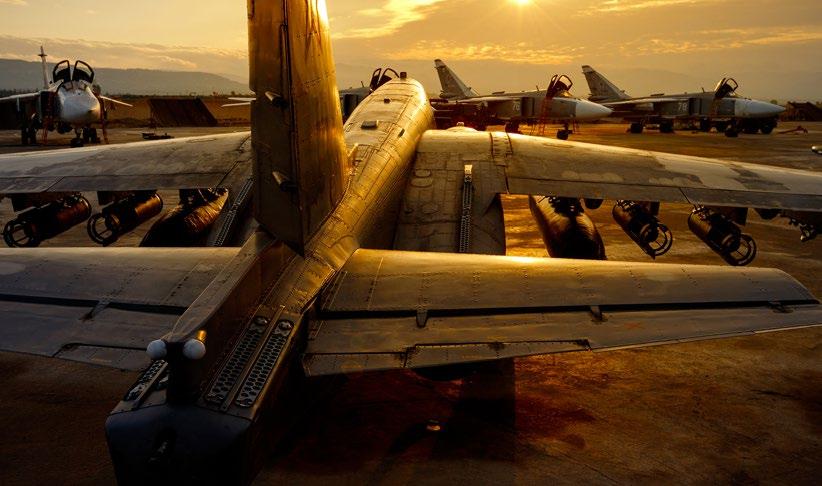
www.warsawinstitute.org 17
SOURCE: STRUCTURE.MIL.RU
to change anything. As Moscow now claims Ukraine’s Donbas and the country’s south have been incorporated into Russia, any Ukrainian military efforts there could trigger a nuclear response. This is a double false claim. According to an updated Russian nuclear doctrine, nuclear weapons could be used by Russia in response to the use of nuclear and other types of weapons of mass destruction against it or its allies, and also in case of aggression against Russia with the use of conventional weapons when the very existence of the Russian Federation is at risk. But Ukraine’s defensive campaign is unlikely to pose a threat to Russia. In addition, Ukraine has targeted Russian military facilities in Crimea for two months; Moscow unlawfully annexed
the peninsula back in 2014. So why would grabbing new territories provoke a nuclear strike only now? However, what it seems is that Putin’s strategy has seen partial success. “The EU must take Vladimir Putin’s threats he could use nuclear weapons in the conflict in Ukraine seriously,” the EU foreign policy chief has said. “When people say it is not a bluff, you have to take them seriously,” Borrell added.
U.S. National Security Advisor Jake Sullivan and U.S. Secretary of State Antony Blinken warned Russia of catastrophic consequences if it uses nuclear weapons as part of the Ukraine invasion. Probably it would be a conventional attack that could at least devastate Russian forces in Ukraine. ■
28 September 2022
GAZPROM’S DIVIDENDS: LESS GAS, MORE MONEY
Russia is making fortune from the gas crisis it has sparked off. Russian gas giant Gazprom has scored brilliantly in the first six months of this year despite a decline in output and exports. The company has thus made an unprecedented decision to pay out a six-month dividend for 2022––interestingly, it did not pay out dividends for 2021.
After Gazprom scrapped its annual payout in 2021, it said the board of directors recommended paying out 51 roubles per share for the first half of 2022. Never before has the company made a six-month payout. Gazprom will pay a record-high 1.2 trillion roubles to its shareholders, which is exactly what it skipped for the past year. The decision, which marks the first time since 1998 that the company has not paid a dividend, has sent shockwaves through the financial market.
Some 33 percent of investors hold Gazprom shares while the Russians might have lost up to 300 billion roubles from 2021 unpaid dividends. In another surprising move, Gazprom recommended paying interim dividends as it had made a record profit in the first half of 2022. What makes up for this is soaring gas prices. Gazprom said its natural gas output was at 288.1 bcm from January 1 to August 31, down 14.6 percent from the same period a year ago. The company also said in a statement that
www.warsawinstitute.org18
its natural gas exports to non-CIS countries (Europe excluding the Baltic states, Turkey, and China) were down 37.4% to 82.2 billion cubic meters (bcm) compared with the same period last year. Gazprom made a record 2.5 trillion roubles in net profit in the first half of 2022, more than doubling its profit from the same period a year ago (968.5 billion roubles). As consequence, the company adjusted its budget scheme. An updated version of the 2022 scheme
takes into account a 34 percent increase in revenues. Famil Sadygov, Gazprom’s deputy chief executive officer, said the decrease in export volumes was offset by an increase in gas prices for non-CIS countries. On September 23, Gazprom increased its 2022 investment program to 1.979 trillion roubles, up 222 billion roubles from the initially expected figure last December. ■
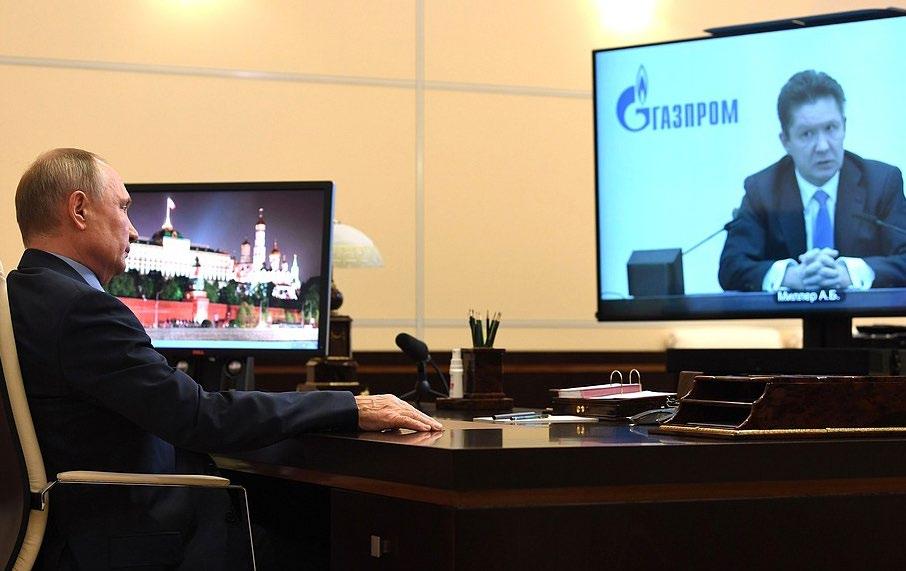
www.warsawinstitute.org 19
SOURCE: KREMLIN.RU
September 2022
RUSSIA ANNOUNCED RESULTS OF SHAM VOTE IN RUSSIAN -OCCUPIED LANDS

Russian-installed officials in four occupied regions of Ukraine reported huge majorities of votes in favor of joining Russia––ranging between 87 and 99 percent. Western countries will refuse to recognize the rigged vote tally. Despite that, Russia is likely to grab these eastern regions of Ukraine that together make up about 15 percent of Ukrainian territory.
Referenda that the West and United Nations have called “sham” votes wrapped up on September 27 in the parts of the Zaporizhzhya, Luhansk, Donetsk, and Kherson regions that are under Moscow’s military occupation.
People were coerced into voting. Russianinstalled officials took ballot boxes from house to house, accompanied by people with weapons. Voting, which lasted a few days and also took place online, favored some rigging schemes,
www.warsawinstitute.org20
SOURCE: COUNCIL.GOV.RU
28
too. Voting was also held in Russia because thousands of residents of the areas that are controlled by Russian forces in Ukraine were deported after the war started. Its result is what everyone could expect. In eastern Ukraine’s Donetsk region, 99.23 percent of those who came to the polls voted for its entry into Russia, while the final result was 98.42 percent in Luhansk, 93.11 percent in Zaporizhzhya, and 87.05 percent in Kherson––all in favor of the annexation. Moscow-appointed heads of the four regions traveled to Russia to submit a formal application to incorporate these territories into the Russian Federation. Perhaps they would be included in the Federal District
28 September 2022
of Crimea––now Crimea and Sevastopol are both parts of the Southern Federal District. Last week, Russian state news agencies said the Federation Council, the upper house of the Russian parliament, on September 29 might consider the accession of occupied Ukrainian regions into Russia, with relevant agreements to be signed the following day. Also on September 30, Putin may reportedly deliver an address to both houses of the parliament. However, on the last day of the vote, Valentina Matviyenko, who chairs the parliament’s upper house, said lawmakers could consider annexation legislation on October 4 as it is unnecessary to hold a special meeting beforehand. ■
PUTIN, XI MEETS IN SAMARKAND: CHINA IS RUSSIA’S SENIOR PARTNER
The Putin-Xi meeting at a regional security gathering in Uzbekistan has seen a reinforced Chinese stance toward Russia. It is Russia’s Putin that seeks Chinese support amid a lingering war in Ukraine and painful Western sanctions. At the summit of the Shangai Cooperation Organization, the Chinese leader symbolically settled Moscow’s consent to influence Central Asia––not only economically.
The Russian Security Council claimed on September 19 that Moscow and Beijing had agreed on “further military cooperation” with a focus on exercises and senior contacts. The Russian Security Council’s secretary, Nikolai Patrushev, was also back then on a visit to China for consultations. However, there was no immediate confirmation from the Chinese of the Russian Security Council’s announcement. This is a continuation of the Chinese wariness towards Moscow. Chinese President Xi Jinping has avoided condemning the Russian invasion
of Ukraine. He has not openly supported it, either. Putin and Xi met on the sidelines of the regional security gathering in Uzbekistan on September 15, where both made typical declarations. The Chinese leader, however, did not change his stance on Russia. The point was to show the growing position of China, including its ties with Russia. “We highly value the balanced position of our Chinese friends when it comes to the Ukraine crisis,” Putin said at the meeting. That is all the Russian leader can count on. Beijing reaps the benefits from
www.warsawinstitute.org 21
sanctions on Russia. Chinese goods snap up the Russian market once Western businesses have quit Russia. China buys Russian-sourced energy at discount prices, which Moscow must accept as it no longer has access to Western markets. Notwithstanding that, a lingering war and a weak Russian army must be what concerns China. If Western-backed Ukraine wins, China will be strategically weakened due to Russia’s defeat in the war against the United States. There would no longer be possible to involve Washington in a two-front war in Europe and Asia. Furthermore, the Chinese army could take a lesson from Russian military mistakes in Ukraine. China has long felt inspired by Russian military training and technologies and it has purchased Soviet- and Russian-made
equipment. A Russian problem in its clash with the NATO-backed army shows that a possible attempt to seize Taiwan could not be as easy as Chinese generals had thought six months before. Beijing thus seeks not so much that Russia wins the war––instead, it hopes Russia will not lose. Indeed, China has exploited Moscow’s vulnerabilities, also in Central Asia. Xi declined a state invitation to Moscow while making his first post-pandemic foreign trip to Kazakhstan whose ties with Russia have soured somewhat. That was the signal sent out to the Kremlin. Putin has no other choice than to swallow a bitter pill, which is why he had agreed to meet with the Chinese leader who flew to Samarkand from Kazakhstan. ■
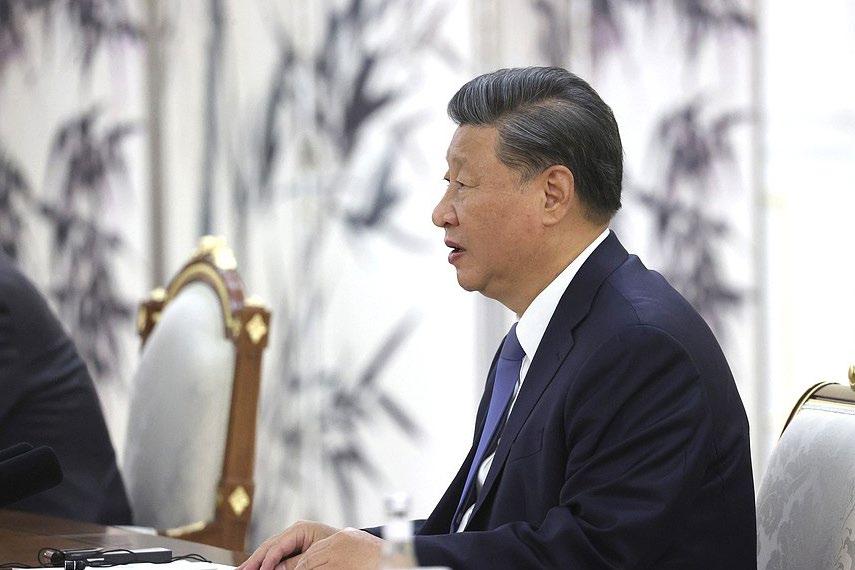
www.warsawinstitute.org22
SOURCE: KREMLIN.RU
September 2022
MONTENEGRO DETAINS RUSSIANS ON SUSPICION OF SPYING
Authorities in Montenegro have detained 36 Russian nationals on suspicion of espionage. Police detained six Russian diplomats, 30 Russian nationals with temporary residence permits, and two Montenegrins, on suspicion of working for Russian intelligence. One of the detained is Radomir Sekulovic, a former spokesperson for the foreign ministry. Montenegro’s services work together with foreign partners, perhaps amid a massive cyber attack that crippled the country in August.
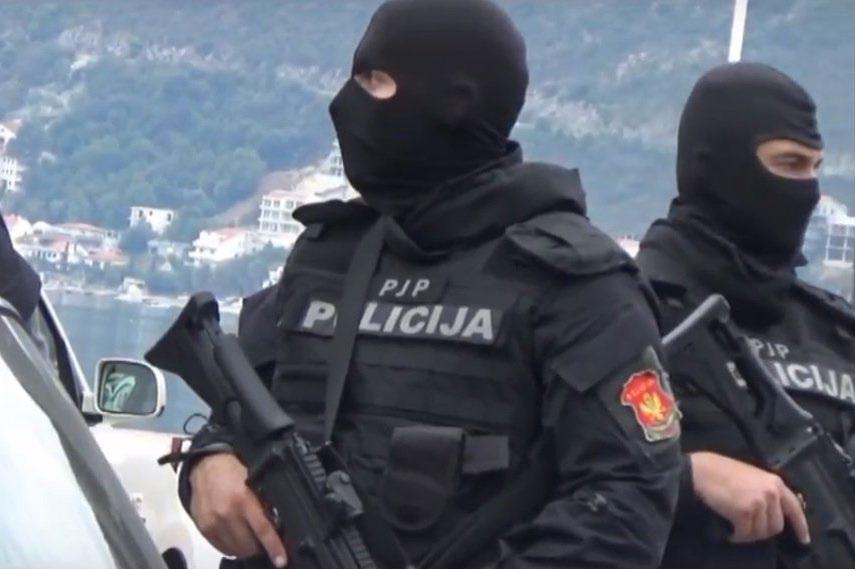
www.warsawinstitute.org 23
30
SOURCE: AKTUELNO.ME
Prime Minister Dritan Abazovic on September 29 said on a live broadcast of a cabinet session that an “international operation” with foreign partners and the state prosecutor’s office was underway to preserve the country’s interests. “Searches are carried out at several locations and the action is international. We are ready to protect the national interests of Montenegro,” Abazovic told RFE/RL. Later in the same day, authorities in Podgorica declared six Russian diplomats personae non grata, asking them to leave the country. Montenegro’s government is struggling to deal with a wideranging cyberattack that crippled governmentrun transportation services back in August. On August 26, the National Security Agency of Montenegro accused Russia of massive cyberattacks on the government server, which forced the public administration to work offline mode for more than a month. A team of cybersecurity experts from the U.S. FBI helps the authorities in Montenegro to investigate the recent massive cyberattack. Last week, outgoing PM Abazovic visited the United States. In his interview for Fox News on September 17, Abazovic said that Montenegro was under negative political and economic pressure from Russia and China, stressing that the U.S. can counter that
influence in Western Balkan countries. Despite strong historical ties, relations between Russia and Montenegro have cooled, particularly since 2014, when Montenegro, seeking membership in NATO, joined previous sanctions imposed on Russia by the EU and the United States over its annexation of Ukraine’s Crimean peninsula and involvement in the fighting in eastern Ukraine. Ties soured further in 2016 when Montenegro accused Russia of sponsoring a failed coup attempt. Montenegro’s Higher Court sentenced 13 people, including Russian military intelligence officers. In February 2021, Montenegro’s appeal court annulled the first-instance verdicts issued in the plot coup trial, citing significant violations of criminal procedure and other major irregularities. Montenegro, a NATO member since 2017 and a candidate for membership in the European Union, has joined international sanctions against Russia over its invasion of Ukraine. After the government decided to join European Union sanctions against Russia, on March 7, Russia added Montenegro to a list of “enemy states”. Since March the Foreign Ministry of Montenegro has declared several Russian diplomats personae non grata. ■
RUSSIAN OIL AND GAS RESOURCES: HOW MUCH AND FOR HOW LONG?
The head of the Rosnedra state agency managing subsoil mineral resources said how much oil
still has at its disposal. Interestingly, his estimates differ much from those
in August by the head of the State Commission on
www.warsawinstitute.org24
and gas Russia
delivered
Mineral Resources. 30 September 2022
In an interview for Russian government-run Rossiyskaya Gazeta, Yevgeny Petrov, the head of the Rosnedra state agency managing subsoil mineral resources, estimated that proven recoverable oil reserves would last the country for 33 years. He said Russia had enough natural gas that is technically feasible to extract to last us for 62 years. These figures depend much on both technology and the market. “Something has happened in the world, with oil prices and security having risen accordingly. And vice versa. What serves a vital role is technology––its cost and availability,” Petrov said in the interview. “Technology progress allows for more accurate horizontal penetration while drilling, which curbs costs, extracts more reserves, and is more economically feasible,” he added. Russia is yet seeing much more of the oil still in the ground that will be more difficult to find and produce. It was 43 percent of the country’s total oil output back in 2020. Had Russia not curbed its output under an OPEC+ deal, this share would have grown more.
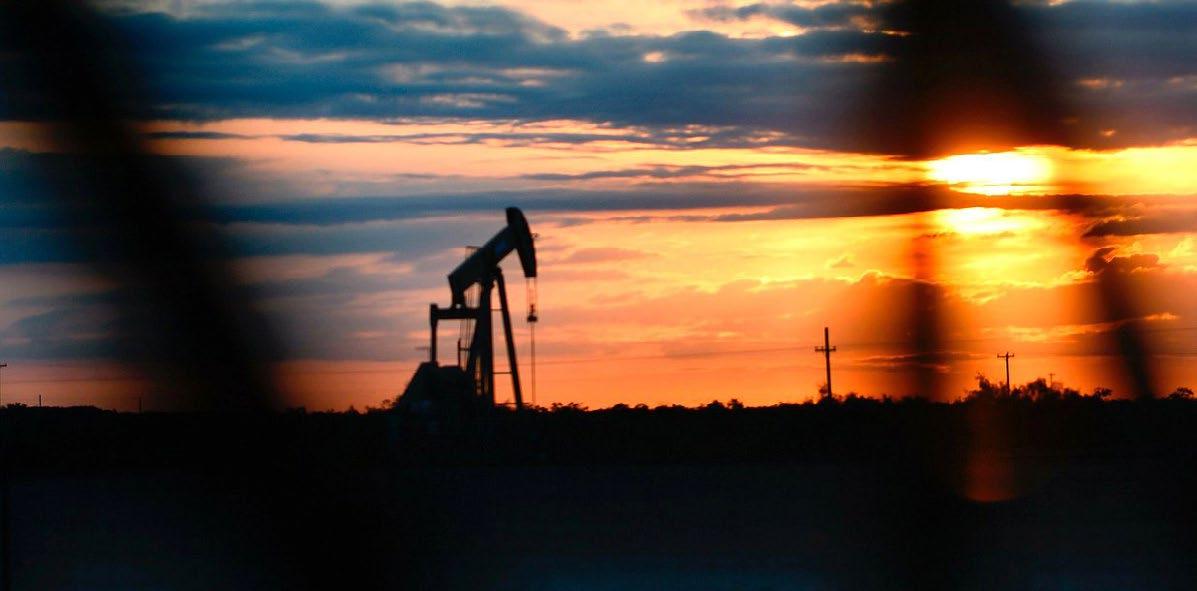
Russia’s proven reserves of oil and gas will suffice for 39 and 80 years, respectively, whereas coal reserves will suffice for an even
longer period in accordance with updated national register data, General Director of the State Commission on Mineral Resources Igor Shpurov said in an article for InfoTEK analytical center. That said, a question arises as to what share of proven reserves will turn out profitable, and how fast they can be brought into development. For oil, such an assessment has been provided. “As a result of inventory taking 65 percent of technological reserves are profitable for production, they may be brought into production quite fast,” he wrote. Meanwhile, the remaining part of oil reserves requires the application of new technologies for production, special tax treatment, and preliminary field development, he said. The increase in reserves and production will be secured through scientific and technological development, which will allow for an increase in the oil recovery rate and efficient development of hard-to-recover reserves. The Russian State Commission on Mineral Resources, or GKZ, is a geology institute that reports to Rosnedra. Distinct estimates show how tough it is to calculate Russia’s proven reserves of oil and gas as too many variables are involved. ■
www.warsawinstitute.org 25
SOURCE: DUMA.GOV.RU
30 September 2022
TALIBAN-RULED AFGHANISTAN IS NEW MARKET FOR RUSSIAN
FUEL
Through a new deal with the Taliban, Moscow is following two goals. First, it embarks on a new market as Western nations are making efforts to destroy Russia’s economy with sanctions. What counts more is that Russia won a new market while economic benefits seem rather secondary. Secondly, Russia is seeking to boost its political influence in Taliban-ruled Afghanistan.
R ussia has approved a provisional agreement with the Taliban government to supply oil products, gas, and wheat to Afghanistan. This is the first international economic deal made by the Taliban and Russia has made a huge step towards recognition for the Islamist
group’s new government in Kabul. The deal would involve Russia supplying around one million tons of gasoline, one million tons of diesel, 500,000 tons of liquefied petroleum gas (LPG), and two million tons of wheat annually. Russia had agreed to a discount to global

www.warsawinstitute.org26
SOURCE:DUMA.GOV.RU
markets on goods that would be delivered to Afghanistan, Acting Afghan Commerce and Industry Minister Haji Nooruddin Azizi told Reuters. He did not elaborate on payment methods, though. Afghanistan is effectively cut off from the global banking system amid sanctions. Russia must also be aware of possible restrictive measures. The deal is the first known major international economic agreement struck by the Taliban since its return to power. The Biden administration had earlier announced it would create a new fund out of some of Afghanistan’s frozen central bank reserves, aiming to alleviate the
30 September 2022
country’s humanitarian crisis. The agreement would run for a trial period, after which both sides were expected to sign a longer-term deal. Russian gasoline and food will be delivered to Afghanistan by road and rail via Central Asian countries and perhaps Iran. Russia does not officially recognize the Taliban’s government, but the deal gives strong legitimacy to the Taliban, designated as a terrorist group by Moscow. Russia is one of the few countries to maintain a diplomatic presence in Afghanistan. An Afghan Taliban trade delegation also visited the SPIEF economic forum in St. Petersburg in June 2022. ■
RUSSIA INCREASES LNG OUTPUT
Russia’s liquefied natural gas (LNG) output rose sharply between January and August compared with last year, according to data from Rosstat, the Russian federal statistics agency.
LNG production totaled 2.4 million tons in August, up 59.2 percent and 2.9 percent against August 2021 and July 2022, respectively. LNG output in the first eight months was at 21.6 million tons, up 13.5 percent last year. In 2021, Russia produced 30.1 million tons of liquefied natural gas against 30.5 million tons in 2020, down 1.1 percent, according to Rosstat. Russian energy producers seek soaring demand for LNG in Asia amid its economic record and a colderthan-usual winter, prompting a further increase in fuel prices. In Asia, LNG prices in the summer jumped ten times above their average last year. And yet LNG sees soaring demand in winter. According to The Nikkei, Asia-based LNG importers, who buy LNG stocks from the U.S. and other countries, have to raise purchase
prices to remain competitive amid soaring gas prices in Europe and scarce Russian supplies. This matters most for developing countries that are short of large foreign-cash reserves. Countries such as Pakistan, Bangladesh, and India have mostly cut back on their LNG purchases as prices became too expensive for many downstream buyers to afford. South Korea has purchased 12 LNG cargoes for delivery for winter in the last few weeks. Japan’s biggest utilities have also shown a bigger demand for LNG supplies since September while China has not yet started to stock up on LNG for winter. Not surprisingly, Gazprom is planning to add a new liquefaction train at its recently launched Portovaya LNG complex in the Leningrad region. The Portovaya station
www.warsawinstitute.org 27
sits on the northeastern bank of the Gulf of Finland, some 60 kilometers away from the city of Vyborg. Its construction started in 2016. It was originally due to start up in 2018
September 2022
SOURCE: PORTOVAYA GAZPROM
but has experienced a series of delays. Once fully commissioned, the Portovaya LNG plant will produce about 1.5 million tons of LNG per year. ■
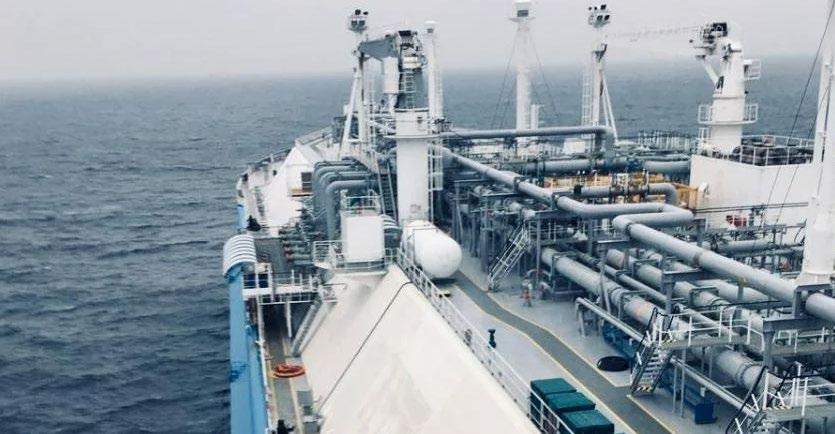
RUSSIA REAFFIRMS ITS COMMITMENT TO DEVELOP PAKISTAN’S GAS SECTOR
Russian President Vladimir Putin met with Pakistani Prime Minister Shehbaz Sharif on the sidelines of the Shanghai Cooperation Organization summit in Samarkand, Uzbekistan. Both leaders agreed to continue economic cooperation, with particular regard to energy projects. According to a 2019 deal, Russian gas giant Gazprom will pump a total of $14 billion into the Pakistani gas sector. Russians would invest around $10 billion in an offshore gas pipeline project, $2.5 billion in the North-South pipeline project, and the remaining $1.5 billion on building underground storage facilities.
www.warsawinstitute.org28
30
SOURCE: KREMLIN.RU
Vladimir Putin said on September 15 that pipeline gas supplies to Pakistan were possible and part of the infrastructure was already in place. The Russian leader met with Pakistani Prime Minister Shehbaz Sharif on Thursday on the sidelines of the Shanghai Cooperation Organization summit in Uzbekistan. It was the first meeting between Putin and Pakistan’s new prime minister who replaced Imran Khan back in April. “The Prime Minister reaffirmed Pakistan’s commitment to work closely with Russia to further expand and strengthen cooperation between the two countries across all areas of mutual benefit including food security, trade and investment, energy, defense and security,” according to a statement issued by Prime Minister’s office in Islamabad. It was agreed to hold the next IGC meeting in Islamabad. The authorities in Pakistan urge Gazprom to speed up the construction of the North-South Gas Pipeline. The long-delayed pipeline was to be built by Russian companies. The project, due to be launched in 2020, was delayed after Russia had to replace the initial participant, which
was hit by Western sanctions. When Pakistan’s former Prime Minister Imran Khan visited Moscow on February 23-24, both sides said they had resolved some 90 percent of issues around the project. The two countries agreed in 2015 to build a 1,100 km-long pipeline to deliver imported liquefied natural gas (LNG) from Karachi on the Arabian Sea coast to power plants in the northeastern province of Punjab. Pakistan and Russia have signed an agreement for the construction of a gas pipeline from Port Qasim in Karachi to Kasur, south to Lahore, at an estimated cost of $3 billion. The pipeline’s designed annual capacity stands at 12.4 billion cubic meters (bcm), with the possibility to be increased to 16 bcm. Pakistan Stream is not the only Russian gas project on Pakistani soil. In 2017, Gazprom signed a cooperation agreement with the Pakistani Oil and Gas Development Company Limited (OGDCL). Under the deal, Pakistan and Russia pledged to develop hydrocarbon projects in Pakistan and other countries, and to explore whether it is possible to supply gas to Pakistan and elsewhere. In 2018, Gazprom and Pakistan signed a $10 billion

www.warsawinstitute.org 29
deal to conduct a feasibility study to build an offshore pipeline from Iran to Pakistan. Back in 2019, the Russian side pledged an investment of $14 billion in the offshore gas pipeline project, North-South Pipeline Project, and underground gas storage facilities in Pakistan. A sea link
September 2022
between the offshore pipeline and the Pakistan Stream gas pipeline is now being considered. The gas pipeline will also have a connection to the Turkmenistan–Afghanistan–Pakistan–India Pipeline (TAPI). ■
UKRAINE CLAIMS CONTROL OF LYMAN, ENCIRCLING RUSSIAN TROOPS
Ukrainian forces encircled Russian forces near the eastern city of Lyman by September 30, marking yet another successful Ukrainian operation after an operation in Kharkiv. Importantly, encircling Russian troops in Lyman and making them surrender paves Ukraine’s way into the Luhansk region. The recapture of the key foothold in Lyman is of major propaganda significance as it took place when Putin announced the annexation of four Ukrainian regions.
The Lyman offensive started as Ukrainian forces were wrapping up an operation in the Kharkiv region. For a few days now, Ukrainian troops had encircled Russian forces stationed since May in Lyman, a city in the Donetsk region bordering the Luhansk region, east of the Donets River. Russian forces remained in Lyman but made no progress as they were ordered not to retreat. At the same time, Ukraine has launched a mass offensive with the use of artillery, HIMARS launchers, and armored vehicles. Additional Russian forces––including new conscripts––failed to get through the city. “We have significant results in the east of our country,” Zelensky said in his daily address to the nation back on September 30. Ukraine’s defense ministry said earlier its troops had captured the village of Drobysheve, some 9 km to the northwest of Lyman. The nearby settlement of Yampil had been liberated
earlier that day. Ukraine said it had taken full control of all roads to Lyman, with recon groups having left for the biggest major link between the city and the Russian-controlled city of Kreminna. Serhiy Cherevatiy, the spokesman for the Eastern Group of the Armed Forces of Ukraine, said the Lyman operation was nearing completion. “Today Russia will have to ask for an exit from Lyman,” Zelensky’s adviser, Mykhailo Podolyak, said on the same day. There are around 5,000 Russian troops encircled in Lyman. Russian forces identified the Russian defenders of Lyman to the BARS-13 detachment, who already had defended the settlement of Dobryshevo, the 752nd Regiment of the 20th Army, the “people’s militia” of Luhansk and Donetsk, and some members of Cossack organizations. Encircling Russian forces in Lyman and possibly destroying them could help the Ukrainian army advance towards Sviatovo
www.warsawinstitute.org30
30
and Starobilsk in the Luhansk region and the Russian border. There is now no Russian army there. The Ukrainians are marching
September 2022
towards the rear of the Russian military group in Kreminna, Rubizhne, Severodonetsk, and Lysychansk. ■
UKRAINE APPLIES FOR FAST -TRACK NATO ADMISSION

Ukrainian President Volodymyr Zelensky announced the bid for Ukraine’s accelerated accession to join NATO in response to Moscow declaring it had annexed four regions of Ukraine, or some 15 percent of the country’s territory. Ukraine’s fast-track admission into the alliance is highly unlikely, with the Russian invasion and illegal annexation complicating the matter even more. Ukraine’s joining NATO now would trigger a war between the alliance and Russia.
Ukrainian President Volodymyr Zelensky said that his country is applying “under an accelerated procedure” to become a member of the North Atlantic Treaty Organization. He
www.warsawinstitute.org 31
SOURCE: TWITTER
30
signed Ukraine’s application together with Speaker of the Parliament Ruslan Stefanchuk and Prime Minister Denys Shmygal. “De facto,” Ukraine had already “completed our path” to NATO, Zelensky told in a speech after the meeting of the national security and defense council. “Today, Ukraine is applying to make it de jure. Under a procedure consistent with our significance for the protection of our entire community, under an accelerated procedure,” he added. The Ukrainian leader cited Sweden and Finland as examples of countries that began the process of joining NATO “without a plan of action.” Zelensky said that while Ukraine waits for consensus among NATO member states, it could be protected under draft security guarantees proposed by Kyiv and known as the Kyiv Security Compact. Estonia, Latvia, and Lithuania fully support welcoming Ukraine into NATO as soon as possible, according to Edgards Rinkeviczs, Latvia’s foreign minister. However, Jens Stoltenberg, NATO Secretary General,
cautioned that any decision on membership has to be taken by all 30 members of the alliance. Washington is cautious to endorse Ukraine’s pursuit. “With regard to NATO and Ukraine, our position is and remains clear, and the same as it has been. We believe in NATO’s open-door policy. We strongly support bringing into NATO countries that seek to join and that can add to NATO’s capabilities. There’s a process for doing that and countries will continue to follow that process,” U.S. Secretary of State Antony Bliken said when asked about Ukraine’s NATO bid. U.S. Congressmen seem somewhat split on what is known as Ukraine’s NATO admission. Ukraine’s announcement that it was seeking an accelerated entry into NATO came as a surprise to the Biden administration, according to Politico. The West fears that Ukraine’s immediate entry into NATO would put the U.S. and Russia at war due to Moscow’s invasion of Ukraine as well as its forced annexations. ■
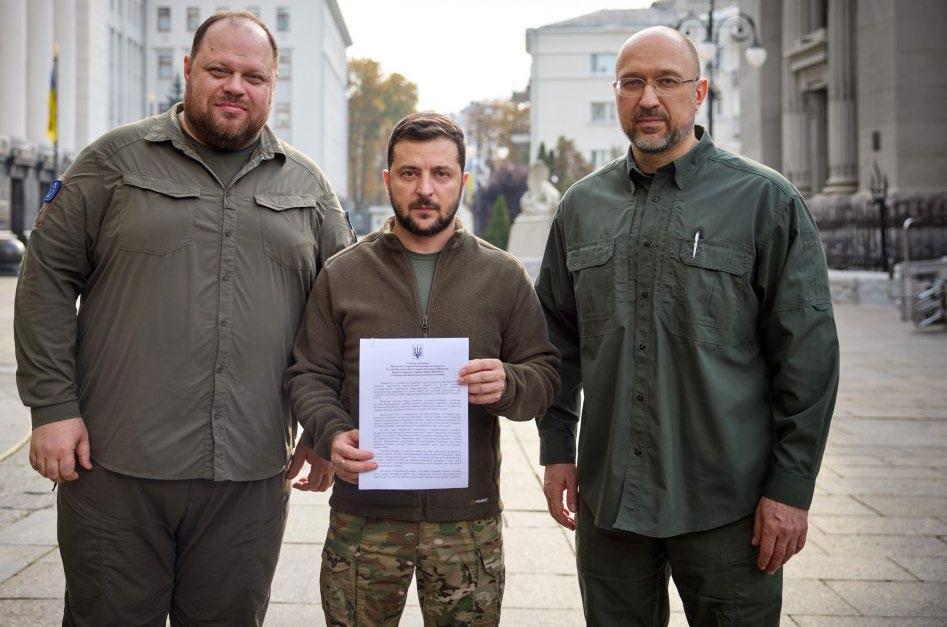
www.warsawinstitute.org32
SOURCE: PRESIDENT.GOV.UA
SOURCE: KREMLIN.RU
September 2022
PUTIN TO FORMALLY ANNEX UKRAINIAN REGIONS
Russian President Vladimir Putin intends to formally annex four territories from Ukraine on Friday September 30. This might mark a turning point in the war––following the invasion and Putin’s announced troop mobilization. Putin has gone to war he will either win or lose. Once Russia illegally annexes four territories of Ukraine, there will no longer be possible for the Kremlin to sit at the negotiating table with Ukrainian officials. This will trigger further sanctions from the West. The suspected sabotage of Nord Stream and nuclear threats might––according to the Kremlin––scare off Ukraine and Western nations.

www.warsawinstitute.org 33
30
Aturning point came last week when Putin announced a “partial” military mobilization of Russian reservists for his war with Ukraine and planned “sham” referenda to include four Ukrainian regions in Russia. Tensions have been running high every single day. Tens of thousands of Russians continue to try to flee the country, fearful of being caught up in the military mobilization. Others are being drafted and sent to Ukraine after what is referred to as two-day military “training”. Earlier this week, simultaneous leaks occurred in the Nord Stream and the Nord Stream 2 gas pipelines––with sabotage being the most likely cause––which makes it difficult to resume gas supplies from Russia to Germany for a few months if at all. A similar scenario was earlier considered Putin’s asset. Furthermore, Russia has repeatedly waved the threat of using nuclear force to have the upper hand in its war in Ukraine. Moscow says it could use nuclear weapons once these Ukrainian territories are annexed––according to the country’s nuclear
doctrine. Despite that, Ukrainian forces have already targeted Crimea which the Kremlin considers part of the Russian Federation. More and more Western governments are asking their citizens to leave Russia. U.S. and NATO officials, including Polish Foreign Minister Zbigniew Rau, say the alliance would use conventional force if Russia used nuclear weapons in its war in Ukraine. What adds to the Russian nuclear threats is what a Moldovan news outlet has reported, saying Russian troops in the Moldovan breakaway region of Transnistria began drills whose scenario involves tackling radioactive contamination. The whole proceedings will see their culmination on Friday September 30. Also on that day, Putin will hold a signing ceremony formally annexing four areas of Ukraine after sham referenda, attended by the Kremlininstalled leaders of the regions. Perhaps this is why Ukrainian President Volodymyr Zelenski has called an urgent meeting of the National Security and Defense Council of Ukraine for Friday. ■
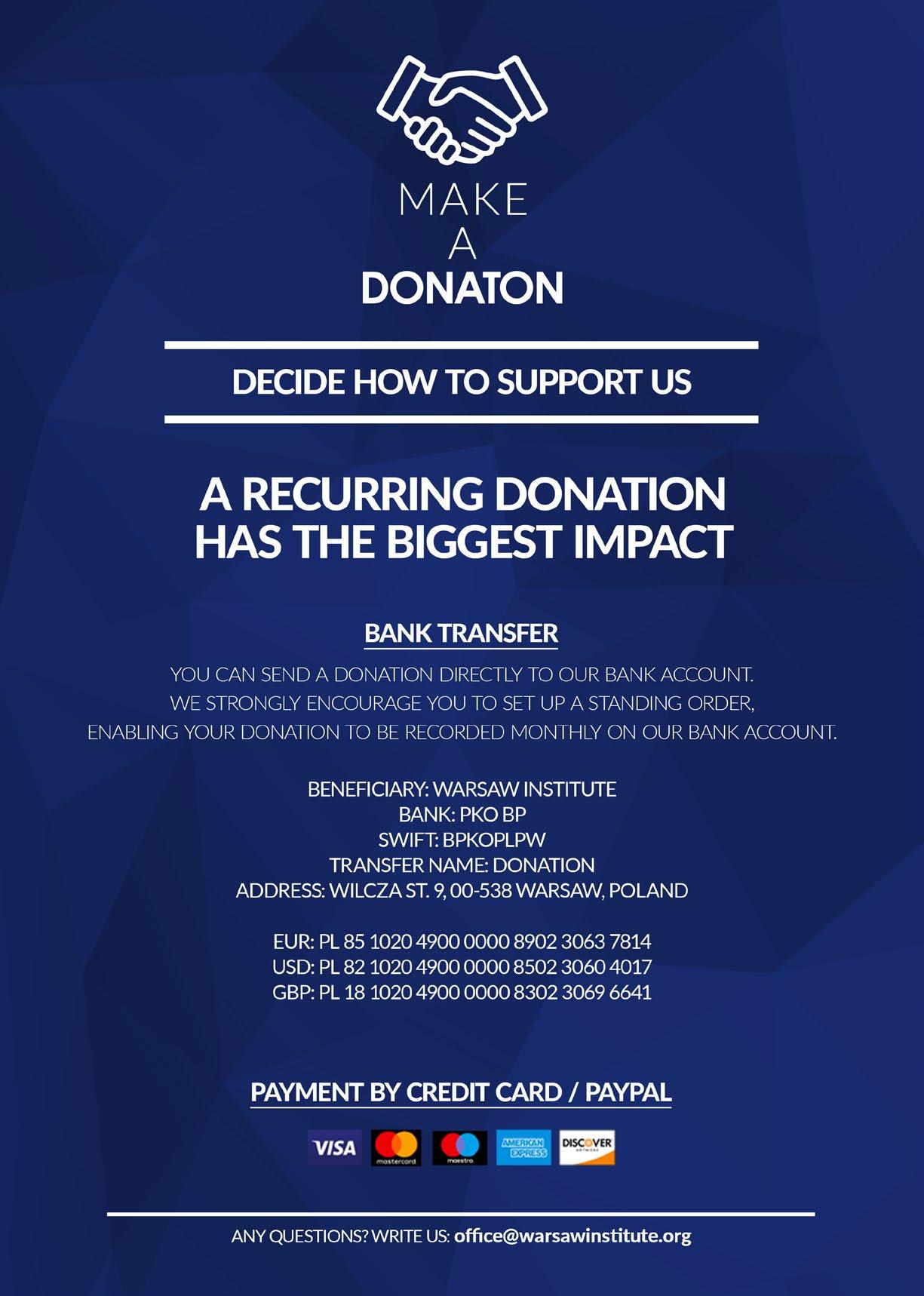
www.warsawinstitute.org34

General information
The Warsaw Institute is the first conservative geopolitical think tank in Poland. The main areas of our interest are: geopolitics, international relations, energy security, defence, history, culture and any other issues crucial for Poland and East-Central Europe. We are proudly supporting the 3 Seas Initiative and transatlantic relations.
The Warsaw Institute develops and provides innovative and practical recommendations based on the wide experience of its experts (over 40 cooperating experts). The Warsaw Institute helps to improve public policy and decision-making through research and analysis. Our activities are dedicated to government organizations and agencies as well as non-governmental organizations, think tanks, research institutes, academic communities, opinion-forming media and experts.
The Warsaw Institute is an independent, non-profit, nonpartisan organization supported by contributions from individuals.
Goals and objectives
• strengthening the position of the Polish state by preparing and providing its partners with analyses and studies concerning economic policy, international relations, security policy, the use of soft power and more
• international cooperation of states, societies and NGOs
• supporting the development of democracy, economy and entrepreneurship
• energy security and military security

• cultivating and promoting Poland’s national and state traditions and developing national, civic and cultural awareness
The Warsaw Institute Review
Free Polish quarterly, prepared essentially for English-speaking readers around the world. Main goal is to present a broad spectrum of topics concerning Poland, a leading East-Central European country, in the form of analytical articles on political, legal, economic, social, historical and institutional issues.
Subscribe to the printed edition of The Warsaw Institute Review on our website.

Programs
Romania Monitor - the first platform that would bring together think tanks and analysts from both countries, interested in geopolitics, energy security and military cooperation between Poland and Romania.
Disinformation Program - this program involve carrying out professional analyses on the identification and creation of methods for combating organised disinformation and training against disinformation threats.
Ukraine Monitor - Warsaw Institute experts monitor and analyse information on Ukrainian politics and business with the view to anticipating the main medium- and long-term changes that can occur in a country playing a key role for many stakeholders.
Baltic Rim Monitor this program offers the analysis of the newest events concerning Baltic basin countries.
Review of the most important events relating to Russian security. Warsaw Institute experts monitor and analyze activities of the Kremlin and its subordinate services to anticipate their short-term and longterm consequences, particularly for neighboring countries and the Western world.

download mobile application


© COPYRIGHT 2022 The Warsaw Institute Foundation The opinions given and the positions held in materials in the Russia Monitor solely reflect the views of authors. The Warsaw Institute Foundation Wilcza 9 St., 00-538 Warsaw, Poland +48 22 417 63 15 office@warsawinstitute.org































